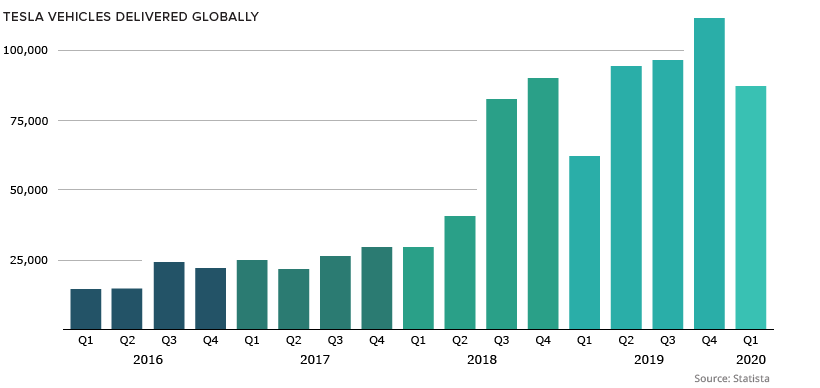The company, which began as a problem-plagued upstart a little over 15 years ago, has now become the world’s most valuable automaker – surpassing industry giants such as Toyota and Volkswagen. This milestone comes after a year of steady growth, which only hit a speed bump earlier this year due to COVID-19’s negative impact on new car sales. Despite these headwinds, Tesla’s valuation has jumped by an impressive 375% since this time last year. How does Tesla’s value continue to balloon, despite repeated cries that the company is overvalued? Will shortsellers declare a long-awaited victory, or is there still open road ahead?
Tesla’s Race to the Top
Earlier this year, Tesla hit an impressive milestone, surpassing the value of GM and Ford combined. Since then, the automaker’s stock has continued it’s upward trajectory. Thanks to the popularity of the Model 3, Tesla sold more cars in 2019 than it did in the previous two years combined:
As well, the company is taking big steps to up its production capacity. Austin, Texas and Tulsa, Oklahoma are currently rolling out the incentives to attract Tesla’s new U.S.-based factory. The company is also increasing its global presence with the construction of Giga Berlin, it’s first European production facility, as well as completing the ongoing expansion of its Giga Shanghai facility in China.
Battle of the Namesakes
Tesla’s most recent price bump was fueled in part by a leaked internal memo from Tesla’s CEO, Elon Musk, urging the company’s staff to go “all out” on bringing electric semi trucks to the global market at scale. – Elon Musk Of course, Musk’s enthusiasm for semi trucks isn’t coming from nowhere. Another company, Nikola (also named after famed inventor Nikola Tesla), is focused on electrifying the two million or so semi trucks in operation in the U.S. market. Although Nikola has yet to produce a vehicle, its market cap has surged to $24 billion – which puts its valuation nearly on par with Ford. Much like Tesla, the company already has preorders from major companies looking to add electric-powered trucks to their delivery fleets. For major brands looking to hit ESG targets, zero-emission heavy-duty trucks is an easy solution, particularly if the vehicles also live up to claims of being cheaper over the vehicle’s lifecycle. The big question is which automaker will capitalize on this mega market first? on
#1: High Reliability
Nuclear power plants run 24/7 and are the most reliable source of sustainable energy. Nuclear electricity generation remains steady around the clock throughout the day, week, and year. Meanwhile, daily solar generation peaks in the afternoon when electricity demand is usually lower, and wind generation depends on wind speeds.As the use of variable solar and wind power increases globally, nuclear offers a stable and reliable backbone for a clean electricity grid.
#2: Clean Electricity
Nuclear reactors use fission to generate electricity without any greenhouse gas (GHG) emissions.Consequently, nuclear power is the cleanest energy source on a lifecycle basis, measured in CO2-equivalent emissions per gigawatt-hour (GWh) of electricity produced by a power plant over its lifetime. The lifecycle emissions from a typical nuclear power plant are 273 times lower than coal and 163 times lower than natural gas. Furthermore, nuclear is relatively less resource-intensive, allowing for lower supply chain emissions than wind and solar plants.
#3: Stable Affordability
Although nuclear plants can be expensive to build, they are cost-competitive in the long run. Most nuclear plants have an initial lifetime of around 40 years, after which they can continue operating with approved lifetime extensions. Nuclear plants with lifetime extensions are the cheapest sources of electricity in the United States, and 88 of the country’s 92 reactors have received approvals for 20-year extensions. Additionally, according to the World Nuclear Association, nuclear plants are relatively less susceptible to fuel price volatility than natural gas plants, allowing for stable costs of electricity generation.
#4: Energy Efficiency
Nuclear’s high energy return on investment (EROI) exemplifies its exceptional efficiency. EROI measures how many units of energy are returned for every unit invested in building and running a power plant, over its lifetime. According to a 2018 study by Weissbach et al., nuclear’s EROI is 75 units, making it the most efficient energy source by some distance, with hydropower ranking second at 35 units.
#5: Sustainable Innovation
New, advanced reactor designs are bypassing many of the difficulties faced by traditional nuclear plants, making nuclear power more accessible.
Small Modular Reactors (SMRs) are much smaller than conventional reactors and are modular—meaning that their components can be transported and assembled in different locations. Microreactors are smaller than SMRs and are designed to provide electricity in remote and small market areas. They can also serve as backup power sources during emergencies.
These reactor designs offer several advantages, including lower initial capital costs, portability, and increased scalability.
A Nuclear-Powered Future
Nuclear power is making a remarkable comeback as countries work to achieve climate goals and ultimately, a state of energy utopia. Besides the 423 reactors in operation worldwide, another 56 reactors are under construction, and at least 69 more are planned for construction. Some nations, like Japan, have also reversed their attitudes toward nuclear power, embracing it as a clean and reliable energy source for the future. CanAlaska is a leading exploration company in the Athabasca Basin, the Earth’s richest uranium depository. Click here to learn more now. In part 3 of the Road to Energy Utopia series, we explore the unique properties of uranium, the fuel that powers nuclear reactors.






























